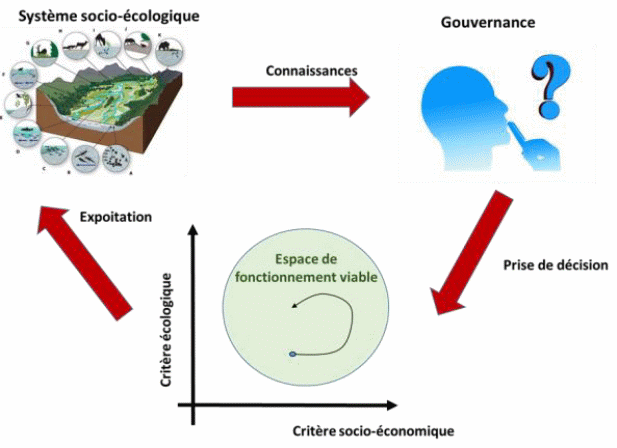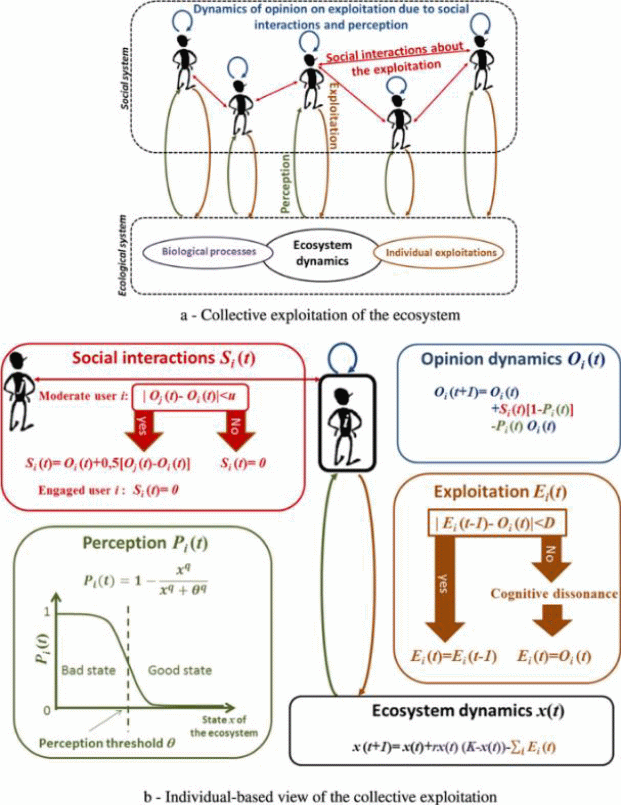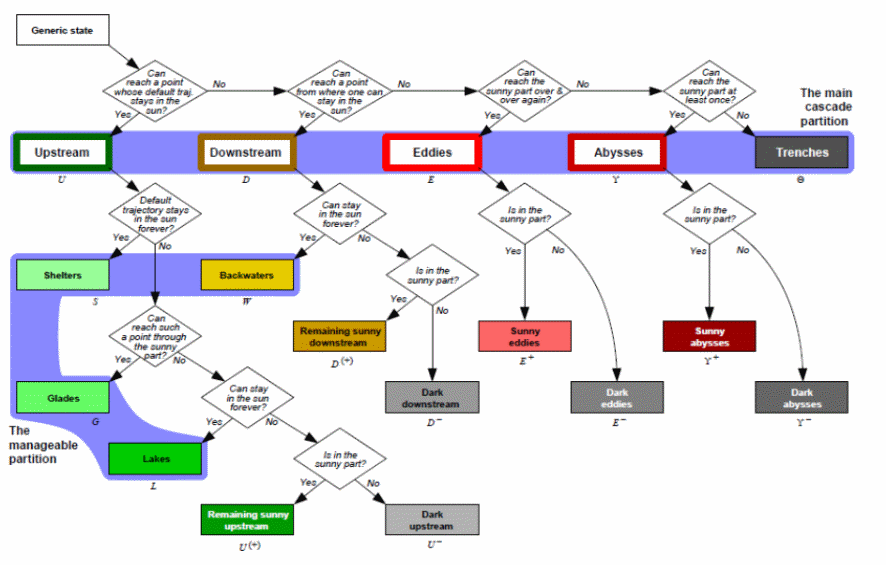Our Scientific Activities
The research conducted by the LISC unit contributes to the study of complex dynamic systems for the sustainable management of environmental systems. The LISC’s modeling activities are structured around two main themes: “Modeling Transitions in Complex Dynamic Systems” and “Developing an Operational Mathematical Framework for Sustainable Management.” A third theme focuses on “Cross-Cutting Methodological Challenges.”
Modeling Transitions in Complex Dynamic Systems
We have focused on “the dynamics of systems in transition”, which examines how these systems evolve over time under the influence of various internal and external factors. More specifically, the LISC’s methodological approach involves studying the emergence of behaviors through:
Agent-based models (ABMs), which simulate interactions between agents, leading to the emergence of collective behaviors that cannot be predicted from individual behaviors alone.
Ordinary differential equation (ODE)-based dynamic systems, which provide a mathematical understanding of system properties through equilibrium analysis (e.g., stability, bifurcation, attraction basins).
These methods are primarily applied to social dynamics, ecological dynamics and socio-ecological model.
Ecological Dynamics
We studied ecological dynamics, particularly meta-community modeling led by F. Jabot, examining the impact of disturbances on metacommunities while considering connectivity (Jacquet et al., 2022), environmental variability (Pouget et al., 2021), and individual plant growth variability (Perronne et al., 2020).
Research on stochastic dynamics focused on species invasion, with contributions from C. Smadi (Billiard & Smadi, 2020; Coron et al., 2021) and the PhD work of F. Lavallée in partnership with EDF (Martin et al., 2020; Lavallée et al., 2019). An individual-based model incorporating the social behavior of an insect colony was also developed (Lavallée, 2022).
Socio-Ecological Integration
Social dynamics were integrated into socio-ecological models to study tipping points (Mathias et al., 2020b), notably with Arizona State University.
Forest modeling was explored through the PhD work of Mojtaba Houballah in collaboration with UR LESSEM (Houballah et al., 2020; Houballah et al., 2021).
A position and review paper on equity issues was published in PNAS (Giang et al., 2024), following a series of workshops organized by MIT, Harvard, and the University of British Columbia.
Socio-ecological models were developed on water quality in relation to organic farming transition, based on Amélie Bourceret’s PhD work with UMR Territoires (Bourceret et al., 2021; Bourceret et al., 2022; Bourceret et al., 2023). Notably, A. Bourceret completed a 3-month research stay at Osnabrück University (Germany) as part of the EIR Agreenium program.
Developing an Operational Mathematical Framework for Sustainable Management
On the other hand, we have sought to “develop an operational mathematical framework for sustainable management” by designing action policies that enable these systems to persist over time while resisting disturbances and preserving their key properties.
Viability Theory Applications
We primarily leveraged viability theory, collaborating with the Potsdam Institute for Climate Impact Research (PIK, Germany) to develop a topological framework for sustainable management. This work distinguishes between different sets of states in a dynamic system based on controllability and desirability (Kittel et al., 2021).
We also explored observability in socio-ecological systems with Arizona State University (M. Janssen and M. Anderies), leading to a publication in PNAS (Anderies et al., 2019).
Viability theory was applied to forest management (with UR LESSEM, Houballah et al., 2023) and livestock systems (with UMR Herbivore, Joly et al., 2022).
Additional work focused on viability-based indicators for robustness (Martin & Alvarez, 2019; Pinsard et al., 2021) and resilience/equity (Martin et al., 2022).
Optimal Control with Spatial Dynamics
With the recruitment of E. Comte in 2020, a new research direction emerged on optimal control incorporating spatial dynamics, notably applied to:
Lake eutrophication (Choquet & Comte, 2023).
Pollution in drinking water catchment areas (Augeraud-Véron et al., 2022).
Cross-Cutting Methodological Challenges
Finally, we addressed transversal methodological challenges essential for advancing the both presented research themes.
Dual Modeling and the Curse of Dimensionality
Developed moment approximation methods to analyze average behavior in opinion dynamics (Deffuant & Roubin, 2023).
Extended tipping point concepts to stochastic systems, introducing the notion of “tipping sets” (Mathias et al., 2024b).
Data-Driven Approaches
Quantitative methods:
Social psychology studies on Schwartz values (with LAPSCO, Bonetto et al., 2021).
Agent-based modeling of reactions to extreme risks (e.g., terrorist attacks, Huet et al., 2019).
Reputation dynamics in economic transactions (with GEMASS, Gargiulo et al., 2019).
Data-driven models for toxic vs. non-toxic cyanobacteria competition (with LMGE, Caen et al., 2024).
Qualitative methods:
Applied Ostrom’s socio-ecological systems (SES) framework to forest management (Pichancourt, 2023, 2024; Houballah et al., 2020).
Studied socio-psychological barriers to resilience (with LAPSCO and UConn, Mathias et al., 2024c).
Agent-based modeling of social dominance theory (with UConn and GEMASS, Huet et al., 2020).
Spotlight on Key Scientific Achievements
To highlight select accomplishments as requested in the report, we emphasize notable milestones reported annually to our institute.
Focus #1 - Optimal Control Applied to Lake Eutrophication
For years, we have studied lake eutrophication using viability theory. The recruitment of Eloïse Comte (2020) enabled integrating spatial dimensions via optimal control. In Choquet & Comte (2023), we analyzed the trade-off between contamination benefits (agricultural/industrial activities) and ecological damage. Key innovations include:
Novel damage function: Based on cyanobacteria concentration (not nutrients), aligning with real-world measurements.
Dirichlet boundary control: Unlike prior work (e.g., Brock & Xepapadeas, 2008), control is applied only at the lake’s edge, enhancing realism.
Coupled PDE system: Integrates nutrient and cyanobacteria dynamics with convection terms, nonlinearities, and Robin boundary conditions.
Theoretical breakthroughs: Existence/uniqueness proofs for weak solutions and optimal control, using lifting operator techniques.
This work underpins the PhD thesis of Ioana Chiru (co-supervised with La Rochelle University), which extends the model with climatic factors (wind, temperature, bathymetry) using satellite and field data from an Auvergne lake. Collaborations include Catherine Choquet (La Rochelle University) and Delphine Latour (LMGE,UCA).
Focus #2 - Keeping Socio-Ecological Systems Within Viable Operating Spaces
Adaptive ecosystem management acknowledges that in an uncertain world, long-term planning is insufficient. Instead, flexible governance rules are needed to adapt to changing contexts. The challenge lies in defining the space of viable management solutions, which requires data and knowledge about system dynamics (e.g., biomass regeneration rates, exploitation levels)—often incomplete. Thus, adaptive management must align with the decision-maker’s understanding of the system.
We developed approaches grounded in viability theory, exemplified by our PNAS paper (Anderies, Mathias, & Janssen, 2019). Using a natural resource exploitation case, we demonstrated that safe operating spaces vary based on management type:
Stochastic viability kernels (probabilistic thresholds).
Ecological knowledge-based strategies (e.g., maximum sustainable yield for fisheries).
These methods were tested under imperfect information to assess robustness. While theoretical, the work has operational implications: it underscores the need to integrate evolving knowledge (e.g., future resource demand, climate impacts) to define viable management boundaries.

Focus #3 - Opinion Dynamics Modeling: Global Recognition
Our research builds on 20+ years of pioneering work in agent-based opinion dynamics, earning international acclaim. Key contributions include:
Foundational models (Deffuant et al., 2000; 2,000+ citations) simulating opinion clustering through virtual interactions.
Extensions addressing:
Radicalization under extremist minority influence (Deffuant et al., 2002).
Repulsive interactions (Huet & Deffuant, 2010).
Fluid, non-equilibrium opinions (Mathias et al., 2016).
In 2022, JASSS dedicated a special issue to mark two decades of research. Our contribution with LAPSCO identified a novel self-assessment bias—first detected computationally, then confirmed experimentally (Deffuant et al., 2023).
Focus #4 - Exploring Pathways for Socio-Ecological Transitions
Human actions and ecological systems co-evolve through complex feedbacks, complicating sustainability efforts (Liu et al., 2007; Folke et al., 2002). Nonlinear dynamics further challenge the identification of transition pathways between system states (Scheffer et al., 2012).
We coupled opinion dynamics ABMs with resource exploitation ODEs to analyze:
Short- vs. long-term trade-offs: High ecological awareness yields immediate benefits but risks long-term inefficacy, while low awareness incurs short-term costs with potential delayed gains.
Policy implications: Incorporating economic/institutional processes (e.g., market mediation, exploitation costs) could reveal additional pathways but increases analytical complexity.
Integrated qualitative-quantitative tools are critical to illuminate tipping points and design socially adaptive policies.

Focus #5 - Automated Classification of System States via Sustainable Management Topology (SMT)
Heitzig et al. (2016) introduced a mathematical framework called Sustainable Management Topology (SMT) to study interactions between system constraints and controlled dynamics. This framework can analyze models distinguishing between default dynamics and one or more management options. Indeed, altering a system’s dynamics in emergencies may require additional interventions.
The model’s state space can be partitioned into distinct regions based on:
System constraints
Intrinsic dynamics
Available management options
SMT enables qualitative analysis of both the system and this state-space partition. Our paper aims to operationalize SMT by computing this partition using viability theory.
Case Study: 3D Dynamic Model
We demonstrated SMT’s operationalization through a three-dimensional model integrating: (1) Atmospheric carbon stock dynamics, and (2) Renewable energy knowledge dynamics.
Constraints:
Planetary boundary for climate change (Rockström et al., 2009; Steffen et al., 2015)→Limits atmospheric carbon.
Social constraint→Annual economic threshold.
Management options: (1) Low-growth policies and (2) Climate mitigation via energy transition.
Challenges & Future Directions
Curse of dimensionality: Viability algorithms face computational limits in high-dimensional systems. Scaling SMT requires improved methods to estimate:
Viability kernels
Their attraction basins
State-space partitions
Theoretical extensions. Future work should incorporate:
Bifurcation phenomena
Stochastic dynamic systems (Anishchenko et al., 2007)
These advancements would deepen our understanding of socio-ecological models and their sustainable management within safe and just operating spaces.

Social Dynamics
We conducted research on social dynamics as part of ANR-funded ORA international projects (coordinated by G. Deffuant for the FuturICT2 and TOREALSIM projects), enabling collaboration with leading teams in opinion dynamics (Universities of Bremen and Groningen). In preparation for a European project, we co-authored a position paper (Mathias et al., 2020a) on the need to integrate social dynamics into Integrated Assessment Models (IAMs) used by the IPCC to address global changes. This collective paper was written by 14 authors from 11 European research institutions.
We also worked on well-being in partnership with Arizona State University (Cloutier et al., 2020) and Athabasca University in Canada (Mathias et al., 2024a), as well as on the emergence of discrimination (gender inequalities) with one of the authors of Social Dominance Theory (University of Connecticut) (Huet et al., 2020), developing a multi-agent model.
Other ABMs on opinion dynamics were developed, revealing a previously undetected cognitive bias (Deffuant et al., 2022; Deffuant, 2023; Deffuant et al., 2024).
Research was conducted on the transition to organic farming in collaboration with LAPSCO (Khamzina et al., 2021) and UMR Territoires (Xu et al., 2020).
Agent-based models were also developed to study rumor dynamics (Deffuant et al., 2019) and reputation dynamics (Gargiulo et al., 2019). The LISC’s work in this field has been recognized with a special issue in JASSS.